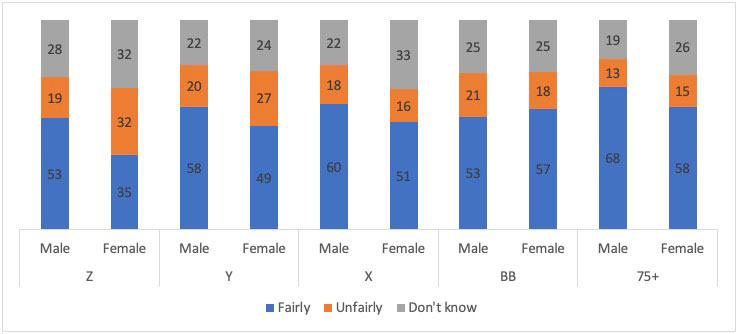Ongoing public discussion about violence against women in Australia has increased attention on the way women are portrayed in the news media.
The Digital News Report: Australia 2021 finds that women, especially young women, are less likely to think the news media represents them fairly than men. The online survey of 2,034 Australian news consumers also found Australian women believe they receive less news coverage than their male counterparts.
They are not imagining things. A recent study examining gender inequality in news coverage in India, Kenya, Nigeria, South Africa, the UK, and the US found women’s voices are often missing.
It is an issue the ABC has been trying to tackle. In March this year, the ABC announced it had achieved gender parity in its news coverage for the first time since 2018. However, audience perception takes longer to change and not all news outlets are attempting to correct the imbalance.
The Digital News Report: Australia 2021 finds more than half of Australians are satisfied with how the news media represent ‘people like them’. However, certain groups feel they are more under-represented than others, revealing a perceived lack of diversity in news coverage.
Australian women are more likely to feel there is not enough news coverage of their gender (16%) than men (10%). The imbalance is acknowledged by 11% of men who say there is too much reporting about them. Only 6% of female participants believed women received too much news coverage.
Gen Z women – those aged 23 or under – feel the least seen by the news media. These young Australian women (26%) are more than twice as likely as their male counterparts (11%) to feel there is not enough coverage of their gender. In contrast, three-quarters of men aged 75+ believe men receive about the right amount of news coverage.
FIGURE 3.3: VIEWS ABOUT THE AMOUNT OF COVERAGE OF PEOPLE YOUR GENDER BY GENERATION (%)

[Base: N=2,034]
In addition to Australian women believing they do not get enough news coverage they are also more likely than men to think news coverage of their gender is unfair. Again, this is particularly true for Gen Z women. Almost one-third of the young women (32%) believe news coverage of their cohort is unfair, compared to 19% of Gen Z men.
Except for Baby Boomer women, men are much more likely than women to think news coverage of their gender is fair.
FIGURE 3.13: VIEWS ABOUT THE FAIRNESS OF COVERAGE OF PEOPLE YOUR GENDER BY GENERATION (%)

[Base: N=2,034]
These findings are not just important to help improve diversity in news coverage. The data also reveal that perceptions of fairness and sufficiency of news coverage about ‘people like me’ impacts on consumer perceptions of trust in news.
Those who feel there is not enough news coverage of the groups they belong to, are less likely to trust news in general. In contrast, those who are satisfied with the way the news media covers them are more likely to trust news. More than half of people who are satisfied with the amount of news coverage their gender receives (52%) say they trust news compared to less than one-third (31%) of those who say there is not enough and 44% who said there was too much.
The report also finds that women continue to be less interested in news than men and consume less of it. Only 48% of women access news more than once a day compared to 60% of men. A similarly low proportion of women say they have high interest in news (47%) compared to 57% of men, and less than one-quarter of women are interested in politics compared to 40% of men. Australian women also get their news via fewer mediums and news brands than men.
Perhaps these poor statistics could improve if women perceived the news coverage of them was fairer and more plentiful. In the context of larger community conversations about gender equality these findings are important. They point to the need for diversity in news coverage, not only in the topics covered, but also in the voices being heard. These findings support a push for greater inclusion and diversity in news content and in the newsroom.
Digital News Report: Australia is produced by the News & Media Research Centre (N&MRC) at the University of Canberra and is part of a global annual survey of digital news consumption in 46 countries, commissioned by the Reuters Institute for the Study of Journalism at the University of Oxford. The survey was conducted by YouGov at the end of January/beginning of February 2021. In Australia, this is the seventh annual survey of its kind produced by the N&MRC.




